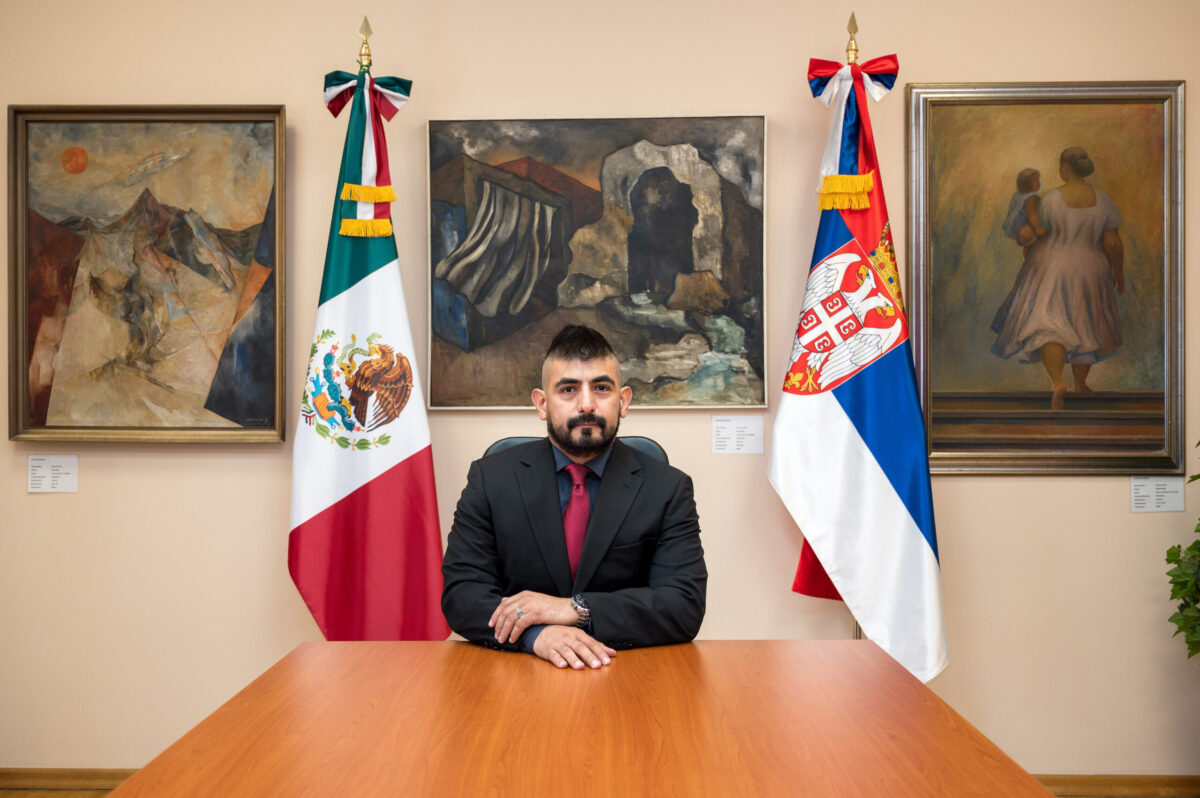Mexico is one of the most open economies in the world with a network of 14 Free Trade Agreements with 50 countries, including the European Union and the Asia-Pacific region
 We spoke with Juan Gabriel Espejo Ceballos, Chief for Economic-Commercial Affairs, Cultural Diplomacy, and International Cooperation at the Embassy of Mexico in Serbia, about the potential for cooperation between the two countries, especially considering the opportunities that Mexico offers.
We spoke with Juan Gabriel Espejo Ceballos, Chief for Economic-Commercial Affairs, Cultural Diplomacy, and International Cooperation at the Embassy of Mexico in Serbia, about the potential for cooperation between the two countries, especially considering the opportunities that Mexico offers.
Given that relations between Mexico and Serbia are very good, while at the same time, the volume of economic cooperation is low, can you tell us the reason?
Mexico and Serbia have celebrated 78 years of diplomatic relations. Both countries have focused on establishing a profound political dialogue and growing cultural cooperation. There are still other areas of opportunity to expand those ties mainly with more economic exchanges.
Mexico is part of North America, the biggest regional market in the world, with more than 450 million consumers, as a result of the entry into force of the United States, Mexico and Canada Agreement (USMCA/CUSMA/T-MEC) on July 1st, 2020, that updated the North America Free Trade Agreement NAFTA signed in 1992. The economic integration of the Mexican economy into the North American market has led Mexico to develop a strong manufacturing sector integrated with value chains in that region. Today Mexico is the first trade partner of the United States, with a volume of trade of $798.9 billion in goods, equivalent to a bilateral exchange of two million dollars every minute. Mexico as well is the first exporter of goods to the US market.

Mexico is one of the most open economies in the world, with a network of 14 Free Trade Agreements with 50 countries (FTAs), including the European Union, and the Asia Pacific region, and with 30 Agreements for the Promotion and Reciprocal Protection of Investments (APPRIs). Mexico and Serbia don´t have yet any of those kind of trade agreements and this is a window opportunity to work together to establish formal instruments to facilitate more trade and investment exchange.
Despite that limitation, the tendency of the trade between the countries is growing. In 2023, Mexico exported to Serbia US$11.5 M, while Mexico imported from Serbia US$117M, with a deficit net trade balance for Mexico of -US$ 105 M. In 2013, the trade between the countries was significantly less. That year Mexico exported to Serbia US$753 K, while Serbia exported to Mexico US$6.62M.
Trade between Mexico and Serbia does not reflect the potential of their economies. In 2023, Serbia was Mexico’s 87th largest trading partner worldwide. Serbia ranked sixth among the rest of Europe. Serbian companies have a lot of opportunities to participate in the Mexican market, with more than 128 million consumers, as well as to expand to other international markets taking advantage of the Free Trade Agreements network that Mexico has around the world.
Trade between Mexico and Serbia does not reflect the potential of their economies
 Where do you see opportunities for improving economic cooperation and increasing trade volume between the two countries?
Where do you see opportunities for improving economic cooperation and increasing trade volume between the two countries?
The opportunities are identified in the areas where both countries are more competitive and where the integration of value chains could lead to improving our competitiveness and diversification of markets. According to our data, the trade between Serbia and Mexico is related to the automotive and electrical-electronics sectors.
Mexico’s top exports are cars, computers, crude petroleum, motor vehicles, and parts and accessories of the automobile industry. Mexico ranks 12th in global food production, exporting products like beer, tequila, berries, avocado, beef, tomato, sweet biscuits, confectionery, pepper, and sugar. Serbia is developing its automotive sector and it has other important economic activities in agriculture and mining. Those are the sectors that both countries should consider to explore.
 Someone told me there is a great interest in Serbian goods in Mexico, but the problem is the small capacity of the Serbian industry, which cannot cover such large markets as Mexico. Is this true?
Someone told me there is a great interest in Serbian goods in Mexico, but the problem is the small capacity of the Serbian industry, which cannot cover such large markets as Mexico. Is this true?
Mexico is now the 12th economy in the world and the second largest in Latin America. Also, it is the 9th exporter in the world and the 12th importer. In Latin America, Mexico’s exports represent 42.8% of the region’s total, consolidating itself as the main export power. With a population of nearly 130 million, and belonging to the biggest regional market on the planet, the opportunities for trade and investment in Mexico are immense. There are a lot of niche markets that Serbian small and medium-sized companies can penetrate to boost their export capacity production.
In which areas do you see the greatest potential for economic cooperation?
As it was mentioned, Mexico has a solid and developed industry, mainly in sectors such as metalworking, automotive, aerospace and electrical-electronic, among others. Consequently, Mexican exports of industrial goods have shown a notable increase, in particular those with high added value, in medium or high technology manufactures. Therefore, most of the opportunities for Serbian companies are in those above-mentioned sectors, which are linked to the value chain export capacity of Mexico. Nowadays most of the Serbian sales to Mexico are in the sector of automotive and electrical-electronic, and there is still more potential in this area.
We have only one Mexican investor in Serbia, the telecommunications company A1. Are others interested, and how can we encourage Mexican companies to invest more in Serbia?
Many Mexican companies are trying to diversify their markets and constantly looking for new opportunities. The agroindustry has shown interest in exporting to the Serbian market. It is important to understand that many Mexican businesses look for economic regions rather than countries. In this sense, the Western Balkans are perceived as an area of economic opportunities. Also, it is important to mention that currently, different regulations for trade and investment in Serbia might change during the process of the economic reforms to the European Union.
In that sense, it is important to facilitate the flow of information about the rules and regulations to trade and establish Mexican companies in the Serbian market. The Serbian Chamber of Commerce and Industry plays an important role in achieving this purpose.
Also, both countries should find common grounds in their projects of economic development for the future and also promote companies´ participation in trade fairs, seminars and symposiums, as well as exchanging information about trade and investment opportunities, among others.
Serbian companies have a lot of opportunities to participate in the Mexican market with more than 128 million consumers
 The number of Serbian tourists visiting Mexico is growing at a very significant rate year after year. Do you have more precise data on the volume of tourism exchange?
The number of Serbian tourists visiting Mexico is growing at a very significant rate year after year. Do you have more precise data on the volume of tourism exchange?
The number of Serbian tourists in Mexico has grown significantly in recent years, and these visitors are increasingly focused on cultural tourism, not exclusively recreational tourism. In 2023, the total air entries of Serbian nationals to Mexico for the year 2023 was 3,982, therefore there is more room to increase the flow of tourism.
We hope that in the coming years, a greater number of Serbian travel agencies will show interest in organizing tours to Mexico, and the Embassy of Mexico can support this purpose, facilitating information that is provided by the Secretariat of Tourism of Mexico.
Also, it is important to highlight that Mexico organizes the Tianguis Turístico every year, where all the Serbian travel agencies can participate in this most important tourist event in Mexico. The Tianguis Turístico aims to promote and market Mexico’s tourism products and services, showing national and international markets the products, offerings and diversity in terms of tourism that our country offers to the world.
In 2025, Tianguis Turístico will take place in the state of Baja California and it will be showcasing the cultural and natural wealth of Mexico and Baja California on a global scale. It will be the ideal setting for Mexico’s 270 tourist destinations, including 177 Magical Towns, to show themselves to the world as the best option to visit.
 As someone living in Serbia, do you think our country could attract tourists from Mexico?
As someone living in Serbia, do you think our country could attract tourists from Mexico?
Serbia has a lot of potential to attract tourists from all around the world. Serbia is a great point to visit, because of its rich history, natural scenery, delicious food, and overall, friendly people.
Mexico registered 46 million departures in 2023, so there are a lot of opportunities to catch the attention of Mexican tourists to visit Serbia and the whole Balkan region. Another opportunity in this area is the technical cooperation on managing tourism. Mexico can share with Serbia its ample experience in managing different segments of tourism.
Is there potential for establishing direct air traffic between Belgrade and Mexico City, or at least in the form of charter tourist flights to Cancun?
There is always potential for increasing connectivity with European countries. Mexico has direct connectivity with some of the main European capitals and hubs, like Madrid, Barcelona, London, Frankfurt, Munich, Paris, Rome, Amsterdam and Istanbul. Charter tourist flights to Cancun or Mexico City could be a great option that airlines should consider. Also, Air Serbia can explore establishing flights to cities in Mexico and the possibility of making arrangements to have connections from there to other cities in the US considering the geographical position of Mexico. Air Serbia can contemplate as well codeshare policy with Mexican airlines to promote more possibilities of cooperation in this area.